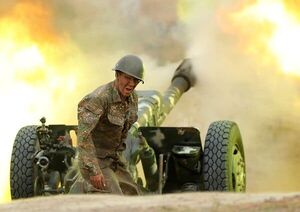Alpachnee War: Difference between revisions
mNo edit summary Tag: 2017 source edit |
mNo edit summary Tag: 2017 source edit |
||
| Line 36: | Line 36: | ||
==Battle of Tarum== | ==Battle of Tarum== | ||
Corummese forces faced only weak resistance on its advance on the regional capital as the majority of local forces retreated into Tarum and made it the lynchpin of Alpachnee's southwest defense. Alpachnee reinforcements streaming south from Umuto ballooned the city's defenders to around 10,000. Crucially for the defense, Alpachnee had in its posession very few anti air systems, mostly older Pelaxian models. During the siege these would prove completely unable to shoot down Corummese drones which picked apart artillery emplacements, troop convoys and strategically important buildings. By November 6th Corummese forces had broken through defensive lines east and west of the city and were close to encircling | Corummese forces faced only weak resistance on its advance on the regional capital as the majority of local forces retreated into Tarum and made it the lynchpin of Alpachnee's southwest defense. Alpachnee reinforcements streaming south from Umuto ballooned the city's defenders to around 10,000. Crucially for the defense, Alpachnee had in its posession very few anti air systems, mostly older Pelaxian models. During the siege these would prove completely unable to shoot down Corummese drones which picked apart artillery emplacements, troop convoys and strategically important buildings. By November 6th Corummese forces had broken through defensive lines east and west of the city and were close to encircling it. Only the highway north to the city of Umuto remained open and was the defender's last line of communication and supply with the rest of Alpachnee controlled territory. By november 7th the Tarum-Umuto highway was within range of Corummese artillery. An Alpachnee counterattack managed to recover five villages east of the highway before being repelled back. On November 8th and under LoN auspices, Corummese and Alpachnee commanders agreed to set up a humanitarian corridor to allow Tarum's remaining defenders to leave the city while abandoning all of their ammunition, vehicles and heavy weaponry. | ||
[[Category:Crona]] | [[Category:Crona]] | ||
[[Category:Wars in Ixnay]] | [[Category:Wars in Ixnay]] | ||
[[Category:Canonical Article]] | [[Category:Canonical Article]] | ||
[[Category:IXWB]] | [[Category:IXWB]] | ||
Revision as of 04:00, 26 October 2020
| Alpachnee War | |||||||
|---|---|---|---|---|---|---|---|
| Part of The Deluge | |||||||
 Kirav boy getting his eardrums blown up | |||||||
| |||||||
| Belligerents | |||||||
| Commanders and leaders | |||||||
The Alpachnee War is an ongoing military conflict between the Republic of Corumm, the Kiravian Federacy and Alpachnee.
Background
Like many native Cronite states, the Alpachnee Confederation, which occupied much of northwestern Crona, was a weak state that had long struggled to balance the competing interests of its many different resident tribal groups, develop strong political institutions, or sustain reliable economic growth.
After the debellation of Nanseetucket and the establishment of Corummese and Kiravian colonial administrations on its former territory, some forces loyal to the old regime took refuge in Alpachnee lands, as did anti-colonial militant groups such as the Revolutionary Guerrilla Triads - Eastern Command.
The inherent weakness of the Alpachnee state and its indifference or complicity with groups hostile to the civilizing endeavours of Corumm and Kiravia marked it for destruction.
Outbreak
Hostilities broke on October 31st 2020 after an Alpachnee aircraft violated Corummese airspace and was brought down by air defenses. Corumm responded shortly after by striking several Alpachnee military sites with unmanned drones and artillery strikes on border posts. A few hours later the Corummese Army of Conquest and auxiliary units from the Peace Brigade began a wholescale offensive into Alpachnee; dubbed Operation Ordertide.
Battle of Tarum
Corummese forces faced only weak resistance on its advance on the regional capital as the majority of local forces retreated into Tarum and made it the lynchpin of Alpachnee's southwest defense. Alpachnee reinforcements streaming south from Umuto ballooned the city's defenders to around 10,000. Crucially for the defense, Alpachnee had in its posession very few anti air systems, mostly older Pelaxian models. During the siege these would prove completely unable to shoot down Corummese drones which picked apart artillery emplacements, troop convoys and strategically important buildings. By November 6th Corummese forces had broken through defensive lines east and west of the city and were close to encircling it. Only the highway north to the city of Umuto remained open and was the defender's last line of communication and supply with the rest of Alpachnee controlled territory. By november 7th the Tarum-Umuto highway was within range of Corummese artillery. An Alpachnee counterattack managed to recover five villages east of the highway before being repelled back. On November 8th and under LoN auspices, Corummese and Alpachnee commanders agreed to set up a humanitarian corridor to allow Tarum's remaining defenders to leave the city while abandoning all of their ammunition, vehicles and heavy weaponry.